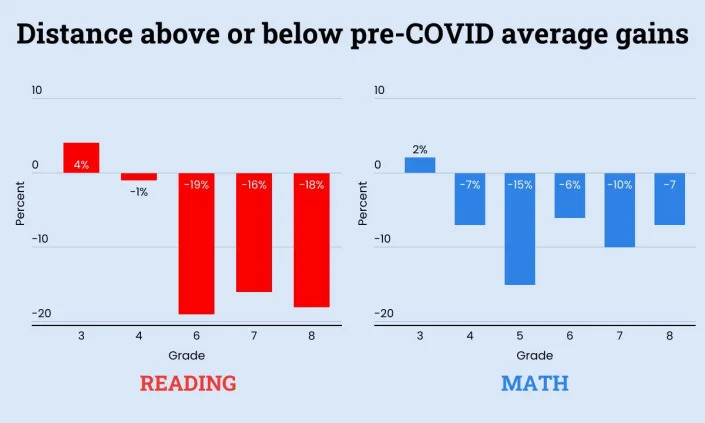Pandemic Emergency May Be Officially Over, But Education’s Long COVID Continues; COVID-19 Pandemic Funding of American Child Care Set to Expire in September, and other C-Virus related stories
Pandemic Emergency May Be Officially Over, but Education’s Long COVID Continues:
The COVID-19 public health emergency officially ended this spring. Unfortunately, the educational emergency coming out of the pandemic is far from over.
According to the latest research from my colleagues at NWEA, COVID’s impacts continue to reverberate through the American school system. Researchers Karyn Lewis and Megan Kuhfeld analyzed test score data from approximately 6.7 million students in grades 3 to 8 in 20,000 public schools who took MAP Growth reading and math assessments last academic year. They then compared the rates of growth for students throughout the 2022-23 school year against typical, pre-pandemic rates.
They found that, in nearly all grades, achievement gains last year fell short of pre-pandemic trends. Because students are behind where they were before the pandemic, they would need to make greater-than-ordinary progress to get back on track. NWEA data show that isn’t happening; over the course of the 2022-23 school year, older students’ movement toward full recovery stalled.
The graph below shows the results in reading (blue) and math (magenta). Third graders showed some sign of rebounding, meaning they had above-normal achievement gains, but students in grades 4 to 8 all gained less quickly last year than what had been the typical pace prior to the pandemic.
NWEA researchers now estimate that on average, students will require interventions and support equivalent to 4.1 months of additional schooling to catch up to pre-COVID levels in reading and 4.5 months in math. Middle schoolers are particularly far behind relative to where their older peers were performing just a few years ago — needing the equivalent of an extra 9.1 months of learning in math and 7.4 months in reading.
Progress for students of all races and ethnicities grew at paces that fell short of pre-COVID averages in 2022-23, but the problem is pronounced for historically underserved students. Given the disparate amounts of unfinished learning that remain as of spring 2023, NWEA researchers estimate that Hispanic and Black students still need an additional 6.4 and 6.2 months of math instruction, respectively, to get back on track. —>READ MORE HERE
COVID-19 pandemic funding of American child care set to expire in September:
Historic funding was secured in the American Rescue Plan to stabilize child care during the COVID-19 pandemic, but is ending in September 2023.
A recent report by the Century Foundation (TCF) estimates that more than 70,000 child care programs will probably close, and leave 3.2 million children without child care.
In Virginia, 88,265 children will lose child care, at least 2,861 child care workers will lose their jobs, Virginia parents will lose $280 million in earnings after forced work hour cuts or leave, and 1,383 child care programs will close.
U.S. Sens. Tim Kaine of Virginia, a member of the Senate health, Education, Labor and Pensions Committee, Tina Smith of Minnesota and Elizabeth Warren of Massachusetts, as well as U.S. Reps. Suzanne Bonamici of Oregon and Sara Jacobs of Colorado are leading a group of colleagues to call on President Joe Biden to support needed funding to prevent a national wave of child care closures.
The effort also includes U.S. Sen. Mark R. Warner and Reps. Jennifer McClellan and Jennifer Wexton, all of Virginia.
“We urge you to join us in supporting an investment of $16 billion a year by any and all means possible — including supporting Congress in efforts to extend the Child Care Stabilization grants passed in ARPA — and through emergency funding for child care in any supplemental appropriations package put forth by the Administration,” the lawmakers wrote. —>READ MORE HERE
Follow links below to relevant/related stories and resources:
Local providers, officials see increase in brain health needs since pandemic
Brain fog and 200 other long-term COVID symptoms focus of new study: ‘A year or two late’
USA TODAY: Coronavirus Updates
YAHOO NEWS: Coronavirus Live Updates
NEW YORK POST: Coronavirus The Latest







Comments are closed.